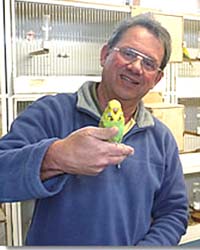
by Jeff Attwood
An added interest was also contained in these six spangles, as
one of them also carried the Australian Goldenface factor which
has also led to many beautiful color variations since that time.
The mutation rapidly became a firm favorite with me and in
subsequent breeding seasons I have produced many interesting
examples. With my visits to
During my last visit I spent three weeks in the State of
Victoria where the Spangle was first discovered and was able to
speak with many fanciers who were directly involved with the
original mutation. I also met the person who brought the Spangle
to
The first Spangles appeared in the aviary of a breeder who
produced birds on the colony system. Although many definite
claims have been made to the Spangle's direct ancestry, in truth
it would appear that no one knows for sure. The aviary involved
consisted mainly of Greywings and Recessive Pieds, and the only
thing that can be definitely determined was that Greywing was
involved.
The full story relayed to me was that additional stock had been
purchased by the Victorian breeder from a pet shop supplier in
I was recently reading an article by an Australian fancier by
the name of Andre Ozouz residing in
We have produced last year a further variation of the Spangle.
This was a bird which showed quite clear Spangle markings on a
Normal Sky Blue cock, but carries solid black spots, and lacked
color pigment in the body color and also the wings, giving large
patches of white, although neither part showed pied
characteristics. I am sure that in the coming years we will also
see further forms of the Spangle emerge.
Finally for the help of fanciers less experienced with Spangles
I have set out below a table showing the genetic inheritance of
the mutation based on the varieties now established, but would
still suggest that the best marked Spangles can be produced from
pairing Visual Spangles X Normal (bred from a Spangle pairing).
Single factor Spangle = S.F.
Double factor Spangle (a clear yellow or white bird) = D.F.
|
S.F. Spangle X S.F. Spangle |
= |
25% D.F. Spangles, 25% Normals, 50%
S.F. Spangles
|
|
S.F. Spangles X Normals |
= |
50% S.F. Spangles, 50% Normals |
|
D.F. Spangle X |
= |
100% S.F. Spangles |
|
D.F. Spangle X S.F. Spangle |
= |
50% D.F. Spangles, 50% S.F. Spangles |
|
D.F. Spangle X D.F. Spangle |
= |
100% D.F. Spangles |
Note: Spangles being a dominant variety, any Normals
(non-Spangles) produced from any Spangle pairing are not in any
form split for or carrying a Spangle gene.
![]() Check
out the articles in our Reference
Library
Check
out the articles in our Reference
Library
